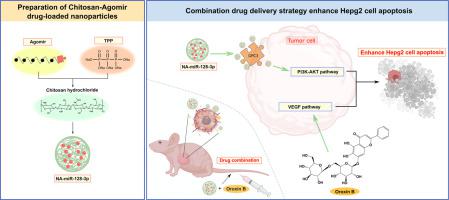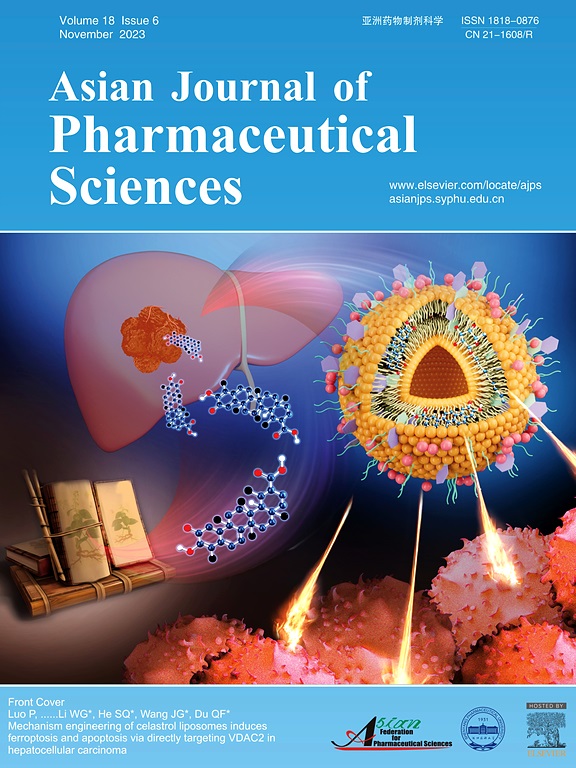Enhancing HepG2 cell apoptosis with a combined nanoparticle delivery of miR-128–3p agomir and Oroxin B: A novel drug delivery approach based on PI3K-AKT and VEGF pathway crosstalk
IF 10.7
1区 医学
Q1 PHARMACOLOGY & PHARMACY
引用次数: 0
Abstract
Hepatocellular carcinoma (HCC) shows the highest morbidity among liver cancers and is a major contributor to cancer-associated mortality. It is characterized by genetic mutations in hepatocytes, leading to uncontrolled cell growth and proliferation. Current treatment include surgery, chemotherapy and immunotherapy; however, chemotherapeutics, which focus on single-targeted drug therapy, are still associated with certain limitations and may affect the treatment outcomes. Compared with chemotherapy drugs, natural products also show the anticancer effect of HCC and hypotoxicity, but overall low activity of natural products limits their further application. MmiRNAs can modulate post-transcriptional functions of target genes. An increasing body of evidence has demonstrated that miRNAs are the key regulators in HCC by targeting different molecules in different signaling pathways. However, miRNAs are fragile and liable to catabolism by RNases in serum and other body fluids and small molecules separated from natural products may have limited bio-availability. According to this background, a chitosan based, targeted sustained-release nanoparticle delivery miR-128–3p agomir (NA-miR-128–3p) was developed in this work. This nanoparticle was prepared by pentasodium tripolyphosphate (TPP), chitosan hydrochloride, and miR-128–3p agomir with target aptamer which was loaded into the chitosan nanoparticle by self-assembly. It can intervene in HCC progress by affecting AKT1 expression. Based on this, a novel, efficient, long-acting, multi-mechanism, low-dosage combination drug delivery strategy was proposed in this work and showed a prominent anti-tumor effect. NA-miR-128–3p combined with natural product Oroxin B significantly affected HCC progression by the interference with VEGF and PI3K-AKT pathways, better than using NA-miR-128–3p and Oroxin B alone. Taken together, this nanoparticle and combinative administration compensate for the shortcomings of the fragile RNA drugs and the low activity of natural products, with high prospects in HCC treatment.


用纳米颗粒联合递送 miR-128-3p agomir 和 Oroxin B 增强 HepG2 细胞凋亡:一种基于 PI3K-AKT 和 VEGF 通路串联的新型给药方法
肝细胞癌(HCC)是肝癌中发病率最高的一种,也是导致全球癌症相关死亡率的主要因素。其特点是肝细胞发生基因突变,导致细胞生长和增殖失控。治疗 HCC 的方法包括手术、化疗和免疫疗法。但以单一靶向药物治疗为主的化疗药物仍存在一定的局限性,可能会影响治疗效果。与化疗药物相比,天然产物也具有抗 HCC 和降毒性的作用,但天然产物整体活性较低,限制了其进一步应用。MiRNA 可调节靶基因转录后的功能。越来越多的证据表明,miRNAs 通过靶向不同信号通路中的不同分子,成为 HCC 的关键调控因子。然而,miRNAs 很脆弱,容易在血清和其他体液中被 RN 酶分解,而且从天然产品中分离出来的小分子可能生物利用度有限。根据这一背景,本研究开发了一种基于壳聚糖的靶向缓释纳米颗粒递送 miR-128-3p 激动剂(NA-miR-128-3p)。该纳米粒子由三聚磷酸钠(TPP)、盐酸壳聚糖和miR-128-3p激动剂制备而成。它可以通过影响 AKT1 的表达来干预 HCC 的进展。在此基础上,该研究提出了一种新型、高效、长效、多机制、低剂量的联合给药策略,并显示出显著的抗肿瘤效果。通过干扰血管内皮生长因子和 PI3K-AKT 通路,NA-miR-128-3p 与天然产物 Oroxin B 联用可显著影响 HCC 的进展,效果优于单独使用 NA-miR-128-3p 和 Oroxin B。总之,这种纳米颗粒和联合用药弥补了易碎RNA药物和天然产物活性低的缺点,在HCC治疗中具有很高的应用前景。
本文章由计算机程序翻译,如有差异,请以英文原文为准。
求助全文
约1分钟内获得全文
求助全文
来源期刊

Asian Journal of Pharmaceutical Sciences
Pharmacology, Toxicology and Pharmaceutics-Pharmaceutical Science
CiteScore
18.30
自引率
2.90%
发文量
11
审稿时长
14 days
期刊介绍:
The Asian Journal of Pharmaceutical Sciences (AJPS) serves as the official journal of the Asian Federation for Pharmaceutical Sciences (AFPS). Recognized by the Science Citation Index Expanded (SCIE), AJPS offers a platform for the reporting of advancements, production methodologies, technologies, initiatives, and the practical application of scientific knowledge in the field of pharmaceutics. The journal covers a wide range of topics including but not limited to controlled drug release systems, drug targeting, physical pharmacy, pharmacodynamics, pharmacokinetics, pharmacogenomics, biopharmaceutics, drug and prodrug design, pharmaceutical analysis, drug stability, quality control, pharmaceutical engineering, and material sciences.
文献相关原料
公司名称
产品信息
阿拉丁
Chitosan hydrochloride
 求助内容:
求助内容: 应助结果提醒方式:
应助结果提醒方式:


